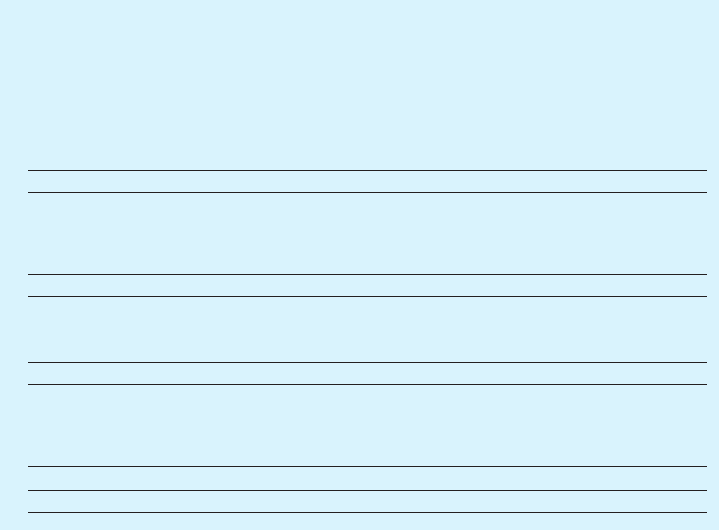
198 CHAPTER 9 GETTING TO NET PROFIT
As the name implies, a finance lease is a sneaky way of financing an asset. In essence, it
produces a liability (to pay for the asset) that is hidden off-balance-sheet. Many countries
have introduced the generally accepted accounting principle that requires finance leases
to be shown on the balance sheet as an asset and as a matching liability. The starting
value on both sides of the balance sheet is the net present value (see Chapter 11) of the
minimum lease payments. Depreciation is over the shorter of the term of the lease or the
assets’ expected useful life. The excess of annual lease payments over the depreciation
charge is charged to the profit and loss account as interest.
Operating leases are just charged to the profit and loss account as an expense (such as
‘computer leases’).
In Chapter 11, I explain some simple arithmetic with an off-putting name. This is the
internal rate of return (the discount rate in net present value). It is used in assessing whether
or not to acquire an asset. It is also helpful when deciding whether to lease or buy – you
use it to compare the relative costs of the two options. Leasing is often especially attrac-
tive to new businesses because it averts a big up-front cash outlay.
‘Expenditure rises to meet income.’
C. NORTHCOTE PARKINSON. OPENING SENTENCE FROM THE LAW AND THE PROFITS
Accounting for fixed assets
This is how you account for fixed assets in your monthly projections. Suppose that:
in October you will acquire a clumping machine for $120,000 (see Figure 9.1);
it has an expected life of five years (60 months);
you are using the straight-line depreciation method.
Outlays are expenditure
You have probably noticed that I tend to refer to capital outlays and operational
expenditure. This is a rather weak attempt at avoiding another ambiguity. Some
bean counters refer to them as capital and expenditure respectively. I do not know
about you, but I class handing over a cheque for an asset as spending. Using the
word outlay almost exclusively in relation to capital spending, I hope to help you
separate it from operational spending.
t

ACCOUNTING FOR FIXED ASSETS 199
Fixed assets detailed
Here is an extract summarising expected monthly spending on fixed assets,
together with the associated depreciation schedule. It helps to open this list
vertically and specify each asset that will be acquired (computer 1, computer 2,
etc.) together with some useful descriptive notes. This creates a detailed capital
spending plan to include in your business plan. If you are starting a business,
you have also created a framework for your fixed asset register and depreciation
schedule. The totals for each category can be carried forward into a summary, as
shown here.
If you are in an existing business, remember that the schedules for the new
assets will have to be merged with the schedules for previously acquired assets.
Spending dollars, whole months Sep Oct Nov Dec
Capital outlays
Machinery 0 120,000 0 0
Office equipment 36,000 36,000 0 0
Computers 0 24,000 24,000 0
… … … … …
Total 36,000 180,000 24,000 0
Depreciation schedule Term*
Machinery 60 0 0 2,000 2,000
Office equipment 36 0 1,000 2,000 2,000
Computers 24 0 0 1,000 2,000
… … … … … …
Total 0 1 000 5 000 6 000
* Term = number of months over which assets are depreciated, in this case using
the straight-line method

200 CHAPTER 9 GETTING TO NET PROFIT
The accounting entries are as follows.
1 In October you debit fixed assets – machinery $120,000 and assuming that you
paid cash, credit cash at bank by the same amount.
2 Every month commencing in November you debit $2000 (120,000 divided by 60
months) to the operating expenditure account depreciation of machinery and credit
the asset account fixed assets – depreciation of machinery with the same amount.
At the end of the first year:
the (original) booked value is $120,000;
the accumulated depreciation is $4000 (two months’ depreciation);
the written-down or net book value is $116,000; and
your operating costs for the year include $4000 in depreciation.
If the only other transaction in the year was an issue of 200,000 shares, the financial trans-
actions for September to December would be those illustrated in Figure 9.1.
Sep Oct Nov Dec
Balance sheet
End month
Assets
Cash at bank 200 000 80 000 80 000 80 000
Fixed assets – machinery 0 120 000 120 000 120 000
Less cumulative depreciation, machinery 0 0 2 000 4 000
Net book value of assets 0 120 000 118 000 116 000
Total 200 000 200 000 198 000 196 000
Liabilities and
shareholders’ equity
Paid up share capital 200 000 200 000 200 000 200 000
Profit (loss), current year 0 0 (2 000) (4 000)
Total 200 000 200 000 198 000 196 000
Profit and loss account
Whole month
Depreciation – machinery 0 0 2 000 2 000
Net profit (loss) 0 0 (2 000) (2 000)
Cash flow
Whole month
Share issue 200 000 0 0 0
Assets 0 –120 000 0 0
Total for month 200 000 –120 000 0 0
Net cash balance 200 000 80 000 0 0
Figure 9.1 Accounting for fixed assets

ACCOUNTING FOR FIXED ASSETS 201
Working life
Machines and things
A quick look through some company accounts shows that typical depreciation
periods might be 3 years for computers, 5 years for office equipment, 10 years
for some industrial machinery, 20 years for a jumbo jet and 100 years for airport
runways (I didn’t think that this last example was reasonable either).
Fitting of premises
Spending on fittings that you cannot take with you – fixed partitioning, plumbing,
cabling, decorating – is treated as freehold improvements (if you own the
premises) or leasehold improvements (if you rent). Such spending is usually
amortised over the shorter of the life of the fittings, the lease or the building.
Research and development
Spending on your research and development team and the gizmos that they
dissect is best treated as current expenditure. However, where there is clearly
identifiable spending on the specific development of a viable product, you may
charge the outlays to capital, show the total on the balance sheet as an asset
(perhaps as product X), and begin writing it off once the product is ready for
market. The amortisation might be over the period during which you will be able
to sell the product, or over a given number of units sold.
Start-up costs
Identifiable start-up costs for a new business – such as incorporation and
professional advisers’ fees and management costs – are often capitalised and
written off over between two and five years.
Goodwill
Goodwill is the difference between the market value of a business and the net
value of the assets. It represents the future cash flow that can be generated by,
for example, trading on a name or location. You cannot show in your accounts the
goodwill value that you attach to your own company. But if you are taken over, the
acquiring company can show goodwill and amortise it over up to 20 years (more
in some circumstances). It is, however, more common in Europe to charge this
directly to shareholder equity.
..................Content has been hidden....................
You can't read the all page of ebook, please click here login for view all page.
